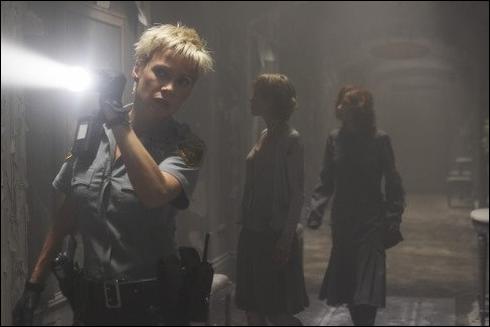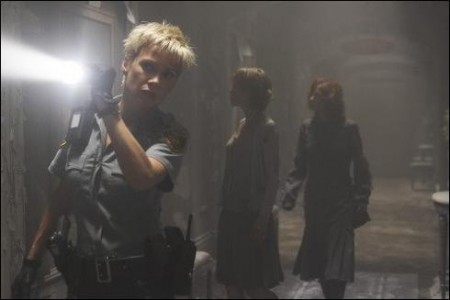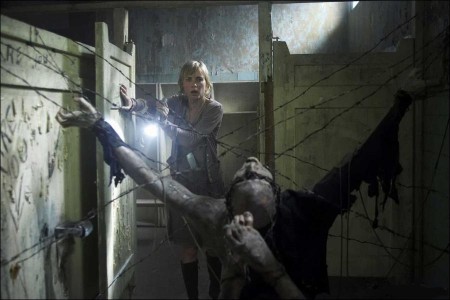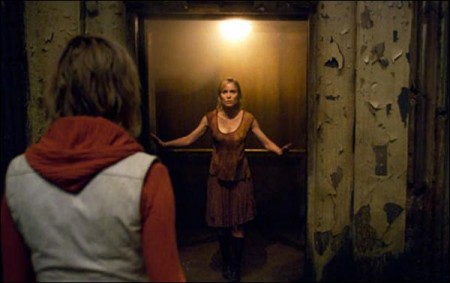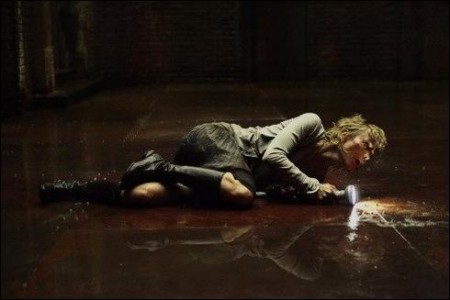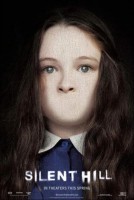Tagline: We’ve been expecting you.
When young mother Rose (Radha Mitchell) — desperate to find a cure for her daughter Sharon’s bizarre illness — refuses to accept a medical recommendation of psychiatric institutionalization, she flees with Sharon and heads for Silent Hill, the town that her daughter continuously names in her sleep.
Although her husband Christopher (Sean Bean) adamantly opposes, Rose is convinced the mysterious town will hold all the answers. But as her car approaches the deserted city’s limits, a mysterious figure appears in the road, forcing Rose to swerve and crash. When she comes to, Sharon is gone, and suddenly Rose – accompanied by a determined police officer (Laurie Holden) from a nearby town — is on a desperate quest in Silent Hill to find her child.
It’s immediately clear that her destination – left alone since devastating coal fires ravaged Silent Hill — is unlike any place she’s ever been: smothered by fog, inhabited by a variety of strange, haunted beings, and periodically overcome by a living Darkness that literally transforms everything it touches. As Rose searches for her daughter, she begins to learn the history of Silent Hill – its violent, puritanical past and the origins of its accursed state — and realizes that her daughter is just part of a larger, more terrifying destiny.
About the Production
For director Christophe Gans, the appeal of making the film of Silent Hill lay in its otherworldliness, its mixture of horror, sci-fi and drama elements, all the while refusing to succumb to the rules of any one genre. “This is a classic Twilight Zone story, dealing with emotions and the supernatural,” says Gans.
“The story, embedded in different dimensions and linked by the fact that everyone is suffering, rests between the tradition of Romanesque melodrama and surrealistic science fiction. What I like is that Silent Hill is a current place, but once you are caught in it, you are condemned to wander there forever. But of course, it’s absolutely mythological; not a normal story at all.” It was while on the set of Gans’ hit film Brotherhood of the Wolf, talking with Samuel Hadida, the producer of the film – and the man behind Metropolitan FilmExport and its production arm, Davis Films – that the idea of transforming the popular video game Silent Hill into a feature film developed.
Brotherhood was the pair’s second film together after Crying Freeman and they instantly latched onto the possibilities inherent in creating a gripping tale and arresting cinematic experience around the idea of a town caught between heaven and hell, trapped by a vicious secret. “Silent Hill is a step beyond what we have seen in cinema,” continues Hadida. “The video game is extraordinarily popular because each gamer experiences something unique when they play it. This film is going to further that experience by adding dimension and mythology to an already amazing concept. I first met Christophe when I was presenting one of my films, Evil Dead at the 1982 Festival du Film Fantastique de Paris; he was there with his short film, “Silver Slime”. Throughout our years of working together, we have been waiting to make a film that would be an homage to the horror genre. Silent Hill is that homage.
Convincing the makers of the game, Konami, to give Gans and Hadida the rights to make the movie was no small task, but Hadida knew the game’s richly visual aesthetics and spooky narrative would dovetail perfectly with Gans’ encyclopedic film knowledge. “It’s a twisted story with enormous reference to the cinema of today because the Japanese creators have taken their influences from the masters of the horror genre,” says Hadida. “Christophe, having seen almost every film ever made, is the right person to reference these genres.
The competition for the rights to the game was fierce. Hadida and Gans found that they were competing against more than a few major Hollywood production companies. What made the difference, and it was the only thing that made the difference, was Christophe Gans’ vision, which he conveyed in a thirty minute on-camera statement to the game’s creator, who in turn took that to the Board of Directors at Konami. Gans took home the prize because Konami felt he was the only one who perfectly understood the essence of the game.
Yet at the same time, the difference in media was crucial to understand. “A game is a game, and a film is a film,” says Gans. “Silent Hill is about diving into a frightening world. What was important in the idea to do a movie was to bring a background story into the foreground. And we wanted to make all the characters grey and ambiguous, very multi-dimensional.” Producer Don Carmody had previously teamed with Samuel Hadida on the blockbuster Resident Evil franchise, and was immediately intrigued by what Silent Hill promised: a movie experience “intellectually interesting, stimulating, and definitely cinematic.”
The Worlds of Silent Hill
Integral to understanding the complex universe of Silent Hill is grasping the many realities and unrealities of the place. “Silent Hill is very different from any other film in the genre,” comments Hadida. “This is a world that exists on four different dimensions or levels of existence: the town of Silent Hill in the 1970s when it was real and existing, Silent Hill now, Silent Hill in the fog state and Silent Hill in the Darkness state. Carmody adds, “it’s an incredibly challenging effort to show all these levels visually and to do so, massive sets were built, requiring five studios to accommodate them all.”
Two of the dimensions have to do with time – reflecting the real Silent Hill of thirty years ago as seen in flashbacks that look like scratchy old film stock, and the real Silent Hill of today, in which Sean Bean’s Christopher has gone looking for his wife. The other two dimensions to the town – the foggy daylight in which Rose tries to find her daughter, and the rust-colored, occasionally enveloping Darkness that represents an evocation of Hell – have to do with space. “I like this idea that we are literally exploring dimensions of space, time and something metaphysical, mystical,” says Gans.
Executive Producer Andrew Mason, who came to this project with a curriculum vitae that includes The Crow, Dark City and the Matrix trilogy, gravitates towards filmmakers who create a complete world. Having spent a childhood reading science fiction, he has a penchant for alternative realities. “This is either a story about what happens in the moments between death and your fate or perhaps it’s a story about the existence of a real alternative dimension some of us get trapped into because we deny our fate,” says Mason. “This film deals with the terror of loneliness, the fear of the dark, the fear of taking responsibility for your own evil side, and the fear of your own fate. In Silent Hill the game, the creators put you constantly in an environment in which everything is potentially threatening and nothing feels like it will ever offer you comfort. This film seeks to reproduce that experience for a wider audience.”
And if there’s some confusion about its altered realities, it’s intentional, Gans says. “We do not try to explain everything because I prefer people to find the meaning in the dream quality of this story. It is more pleasurable to enjoy the opacity. It is a playful invitation to be intelligent.”
In adapting the game, Gans did make a crucial change to the story – the protagonist of the film is female, rather than male. “If you deal with disturbing issues such as we do in the film, you must have a saving grace,” he says. “Bringing women into the story, (the cast is almost entirely female), was my way of doing that. By putting the issues on a feminine level, it makes them more complex and, at the same time, more ambivalent.”
The leitmotiv in “Silent Hill” is motherhood, faith and persecution, all presented on a symbolic level. Gans’ film Brotherhood of the Wolf (which he regards as his ‘boy’s film’), features Mani, a shamanistic Aboriginal who believed in the forces of nature. Silent Hill is the feminine counterpart in which Gans explores the force of motherhood against intolerance. “Rose, as Sharon’s adoptive mother, loves the child so much, Sharon becomes her own. In this way, motherhood in the film is about Immaculate Conception – motherhood achieved in the noblest way. And that is the saving grace of the film. All these female characters have different ways of coping with motherhood.”
Complementing Rose is Cybil, the childless police officer who adopts Rose’s quest; Dahlia, the suffering mother who lost her child to a fanatical sect; Christabella, the religious leader who has turned away from motherhood for what she believes is the greater good of the community; Anna, the innocent who grasps onto anything that fashioned itself as a mother; and Dark Alessa, who tends to her namesake with all the savagery that the maternal instinct can mobilize.
By the time Silent Hill reaches its devastating conclusion in the suddenly unfriendly sanctuary of a witchobsessed cult, Gans’ film has coalesced into a cautionary tale of the dangers of religious fanaticism that evokes the disturbing history of witch hunting. “In the 17th and 18th century in Europe, the witches who were persecuted were women who wanted to be free, who wanted to be considered as conscious entities,” Gans details. “Monotheistic religions constantly attack the idea of femininity and this is something that was clearly in my mind. But I am not moralizing. I try first to tell a story and if audiences dig into it, they might find what I like and what I don’t like.”
Mason concurs. “Anyone who’s seen Brotherhood of the Wolf knows there’s a very sure hand at the helm of this movie. They’d know this was someone who enjoyed the grandeur that cinema has to offer and who could bring vast and amazing adventure alive on the screen. But what they didn’t perhaps see was how twisted and surrealist a brain he has, and this is an opportunity for him to put those things together.”
Cinematographer Dan Laustsen returned to work with Gans once again, having shot the director’s hit Brotherhood of the Wolf. “Christophe has a very clear vision of what he likes and it’s just fantastic,” explains Laustsen. “I’ve never worked with anyone who knows so much about movies. He’s completely visual. I’m sure he has seen all the movies in the world. In the case of Silent Hill, it is not horror, horror, horror. It’s scary, but it’s very poetic with beautiful, sweeping images and that’s its power.”
While adapting a game experience to screen is similar to adapting a novel, it is not the same. A novel is often compacted, but this video game has been distilled. Akira Yamaoka, the creator of the Silent Hill video game, embraced the work of French surrealists, like Hans Bellmer and modern artists such as Francis Bacon, blending in a healthy serving of Kafka. “It’s logical to approach a film version from a French surrealist point of view, which Christophe does,” explains Mason. “In Silent Hill, there are layers and layers of story and every time you think you understand, something occurs that makes you reevaluate everything. Adapting this game is more about finding its essence, as well as taking as much familiar material as possible, retaining the intensity of the mystery and suspense.”
“I cried when I played “Silent Hill 2,” ” recalls screenwriter Roger Avary. “It’s a beautiful piece of art and it will always exist. But we had to disassemble it and create something new.” Together Avary and Gans spent hours and hours studying not just story elements and details, but how the camera floats through the game. “The one element we always felt we must remain true to is the spirit of the material,” Avary continues. “If not, then all is lost.”
And what is the spirit of this fever dream called Silent Hill? Avary explains, “That was the one great and true struggle Christophe and I had. I believe in forgiveness and Christophe believes in justified revenge, and I think Christophe won.” Comfortable with the results, Avary explains, “Christophe understands Silent Hill as well as, if not better than the creators of the game. First as a player, then as a writer and then a director, Christophe absorbed the necessary metaphorical elements of the material and then layered on his and my and everyone else’s interpretation of the material. You could have had a million different filmmakers do their own interpretation of this, but there aren’t any who are as media hungry as Christophe. He absorbs all manner of manga, novels, movies, TV shows, video games, and music. He was the one to make this movie because he lives and breathes the material.”
Ultimately, Avary believes Silent Hill has a richly unclassifiable quality to it. “Is it a relationship drama? Is it science fiction? Is it atmospheric horror? Is it an apocalyptic film? What Christophe has created is unlike anything else that has been put to film. One of the things about Silent Hill is that it defines itself.”
These production notes provided by Sony TriStar Pictures.
Silent Hill
Starring: Radha Mitchell, Sean Bean, Laurie Holden, Deborah Kara Unger, Kim Coates, Tanya Allen, Jodelle Ferland
Directed by: Christophe Gans
Screenplay by: Roger Avary
Release Date: April 21, 2006
Running Time: 127 minutes
MPAA Rating: R for strong horror violence and gore, distrubing images, language.
Studio: Sony Tristar Pictures
Box Office Totals
Domestic: $46,982,632 (48.1%)
Foreign: $50,624,821 (51.9%)
Total: $97,607,453 (Worldwide)
